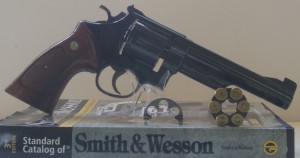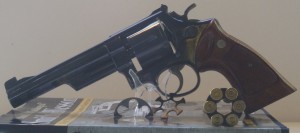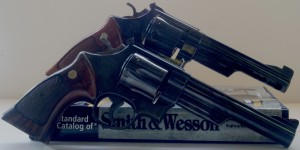For reasons I can’t fully explain, I’ve wanted a revolver chambered in .45 ACP.
When I went to my first S&WCA convention in Sturbridge, I was able to shoot one at the Smith and Wesson Shooting Sports Center. The gun I rented was a Model 625 JM. (The “JM” is for “Jerry Miculek”, who shoots for the Smith and Wesson factory team. The 625 is the gun he used to fire 12 shots in under three seconds, including a reload.) Model 625 revolvers show up used fairly frequently, and I’ve been tempted by them. But either I’ve not had the ready cash, or haven’t quite been able to overcome my bias against shiny guns. (Also, many of the used ones I’ve seen have these kind of pastel grips, for want of a better description, and those also turn me off.)
I think my affection for the .45 ACP revolver has something to do with being drawn to the oddball and unusual. With most revolver cartridges – your .38 Special, .357 Magnum, .44 Special/Magnum, etc. – the cartridge has a rim around the bottom. When you go to unload your revolver, there’s a little metal piece (“extractor star”) that catches the rim and pushes the cartridge out of the cylinder. With most automatic pistol cartridges – 9mm, .40 S&W, .45 ACP – the cartridge doesn’t have a rim, so there’s nothing for that bit to catch on, and the cartridge remains stuck in the chamber until you push it out with something like a pencil or cleaning rod.
This wasn’t a big deal until World War I. The military couldn’t get 1911 automatic pistols fast enough to supply everyone who needed a sidearm. Their other choice was to issue revolvers, but they didn’t want to deal with the logistics of having both an automatic pistol and a revolver caliber. They wanted revolvers that could easily use the same .45 ACP cartridge that the 1911 used. One of S&W’s engineers invented something called the “moon clip”, which comes in “half” and “full” moon variants. Cartridges snap into cutouts in the clip (a half-moon clip has three cutouts, a full moon clip has six), and then the clip is loaded into the gun. When you go to unload, the extractor star catches the moon clip and pushes it, and the fired cases, out of the gun. Moon clips are basically a primitive form of speedloader. Not that it matters that much in a defensive gun, but they are also a lot cheaper than a speedloader. (Amazon will sell you an eight pack of full moon clips for $8.95 with prime shipping. A single Safariland speedloader will run you about $11 to $16.) And there’s very little that can go wrong with a moon clip; it’s just a piece of stamped metal with no moving parts.
(Side note: you can also get revolvers and moon clips in 9mm and .40 S&W. There’s also been a trend towards moon clips in some of S&W’s .357 Magnum revolvers.)
Here’s a video from YouTube that explains how moon clips work. And no, I’m not just dropping this here for my own reference.
After the jump, more words! More pictures! You can do anything with words and pictures!
This is a Smith and Wesson Model 25-2 chambered in .45 ACP with a loaded full moon clip and an unloaded half moon clip. Before S&W went to using model numbers, this was known as either the 1955 Model .45 Target Heavy Barrel (according to the Standard Catalog or the .45 Hand Ejector Model of 1955 (according to Jinks). Here’s another view of the same gun, this time with an empty full moon clip:
This is just about as far away as you can get from the Kit Gun as you can get, though I do find it elegant in its own way. The Model 25 is built on the “N” frame; it is a sister gun to the .44 Magnum, the .41 Magnum, and the early .357 Magnums.
(Please permit a brief sidebar on S&W frame sizes. Smith and Wesson generally designates frame sizes with a letter. They built some small guns (the “.22 Hand Ejector” series) around the turn of the century on what they called the “M” frame. After that, they used the “I” frame for guns like the .22/32 Kit Gun, and the “J” frame for smaller revolvers like the Chiefs Special/Model 36 (the kind of gun you’d recognize from 70’s cop shows). After that comes the “K” frame and the sort of medium-sized “L” frame.
The 25-2 is based on what’s known as the “N” frame, the same one used for the .44 Magnum. Up until a few years ago, the “N” frame was the largest, heaviest, and strongest frame S&W used. The newer .500 Magnum/.460 Magnum revolvers are based on an even larger and heavier frame called the “X” frame. And I am oversimplifying things just a bit; if you’re that curious, you can check out one of the references I’ve cited for more details.)
I was told this particular example had been “messed with”; specifically, the trigger was replaced with a narrower one, and the hammer was probably replaced as well. This may have accounted for the price being a bit more reasonable to my pocketbook; I bought it to shoot, not to collect, so I didn’t care that much about it being in original condition. Looking at it some more, though, I am tempted to see if I can find a “target trigger” (which is wider than the standard, giving more area for your finger to bear against) and a “target hammer” (which is also wider, making it easier to cock) just for grins. The 6″ barrel may be slightly unwieldy, but I think it’d be big fun to take this gun out and shoot it in a bowling pin match. That’s pretty much what this gun was built for: Smith and Wesson originally designed it for target shooters.
One more photo. The gun in front is my Model 25-5, which is pretty much the same gun but chambered in .45 Colt instead of .45 ACP.
Sources:
- Tam’s post on her Model 1955 .45 Target.
- The Standard Catalog of Smith & Wesson
by Jim Supica and Richard Nahas.
- History of Smith & Wesson
by Roy Jinks.
Any errors or oversimplifications in this entry are, again, exclusively my fault. Reproduction without the express written permission of Major League Baseball is encouraged, ESPECIALLY to COMPUTER BULLETIN BOARDS.



Love the moonies!
A S&W 325 PD is one of my main carry guns. I also have a 1917 that was built in December or 1917 that is an absolute tack driver.
Glad you got one, and it is a stellar example. Congrats
Thanks. I love just looking at it, but I haven’t shot it yet. (I’m waiting for my next range trip with MtM to shoot both that and the Kit Gun.)
I also need to find a de-cliping tool. Actually, I probably just need to order one from Brownells and hope it gets here before the 4th. The Mountain of Geese didn’t have one, but I didn’t really expect them to. I don’t know if McBride’s would, but they’d at least probably know what I was talking about.